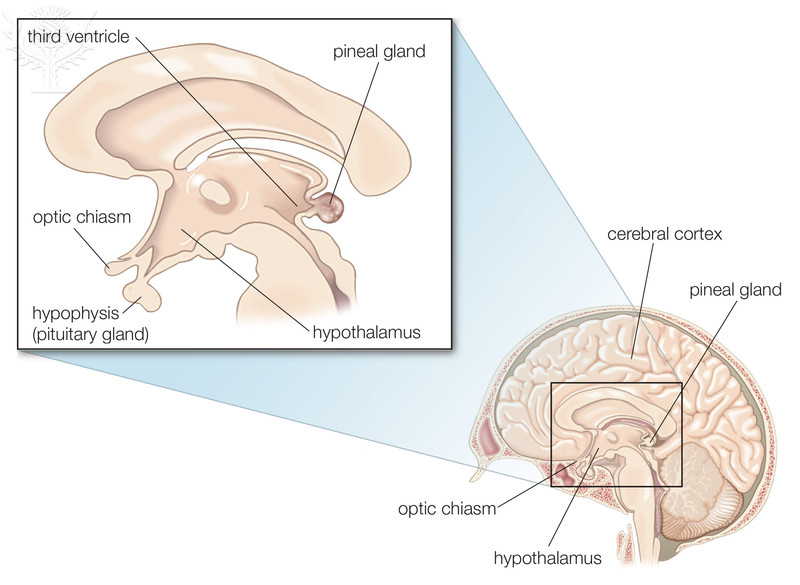THE BRAIN
THE DIENCEPHALON
The diencephalon (interbrain) is a region at the core of the brain and is surrounded by the cerebral hemispheres. It is the connection between the brain stem and the cerebrum and consists of three gray matter structures; the thalamus, the hypothalamus and the epithalamus (see figure below).

© 2013 Encyclopædia Britannica, Inc. Downloaded from Image Quest Britannica; BYU-Idaho.
Diagram illustrating the diencephalon, including the thalamus, hypothalamus and epithalamus (pineal gland).
The Thalamus
By the simplest definition, the thalamus is the sorter or relay center for information coming into the cerebral cortex from all parts of the body (sensory impulses). With the exception of smell, afferent neurons from all parts of the body converge and synapse in the thalamus which in turn relays the information to specific regions of the cerebral cortex. The thalamus edits and sorts out information and then categorizes similar functions to be relayed as a group to the appropriate areas of the cerebral cortex. Thus, specific localizations and interpretation of stimuli occur in the cerebral cortex but only after careful sorting through the gate keeper, the thalamus. A recent study suggest that the thalamus plays an important role in our ability to concentrate on the task at hand by ignoring distracting sensory input. (Wimmer et al. "Thalamic control of sensory selection in divided attention," Nature, October 21, 2015. DOI: 10.1038/nature15398). It also plays an important role in regulating out states of sleep and wakefulness. In addition, it is thought to play an important role in maintained the aroused state and damage to the thalamus can result in coma.
The Hypothalamus
The hypothalamus is so named because of its position below the thalamus. The hypothalamus is the visceral control center, it regulates functions of the internal organs. As such, it is chiefly concerned with maintaining homeostasis. Due to the key role it plays it maintaining normal body function it is sometimes referred to as the brain within the brain. Some of the important functions of the hypothalamus are listed in the table below.
Table: Select homeostatic roles of the hypothalamus.
|
The autonomic nervous system |
The autonomic nervous system is a system of neurons that automatically regulate function such as heart rate, blood pressure, digestion, etc. (functions we don't have to consciously think about). The hypothalamus regulates many of the activities of the activity of the autonomic nervous system by controlling centers in the brain stem and spinal cord. |
|
Emotions |
Hypothalamic neurons are involved in the perception of pleasure, fear and rage. |
|
Body temperature |
Select groups of hypothalamic neurons monitor blood temperature directly as well as respond to inputs from other thermoreceptors throughout the body and then send appropriate signals to systems that help regulate body temperature such as sweat glands. |
|
Food intake |
Select neurons respond to blood levels of nutrients and regulate feelings of hunger or satiety. |
|
Water balance |
Osmoreceptors (modified neurons) in the hypothalamus respond to changing salt concentrations in the blood which in turn elicit responses from the kidneys as well as regulate thirst. |
|
Sleep |
Neurons in the hypothalamus have been linked to our biological clock. |
|
Endocrine system |
The hypothalamus regulates the pituitary gland. A major endocrine organ gland that regulates numerous body functions including metabolism and reproduction. |
The Epithalamus
The epithalamus is the most dorsal of the structures of the diencephalon. Within the epithalalmus are several important structures including the habenular nuclei and the pineal gland. The habenular nuclei have been shown to have involvement in several limbic system type functions including negative reward processing.
The pineal gland secretes the hormone melatonin in response to the light dark cycle (melatonin secretion is stimulated by the dark and inhibited by light). Melatonin has been implicated in the regulation of our sleep patterns and in regulating reproduction in seasonal breeding animals (see endocrine modules). Melatonin my play an important role in puberty as pineal tumors have been linked to the onset of precocious puberty. The habenular nuclei are thought to be involved in pain processing, reproductive behavior, learning, sleep-wake cycles, stress responses and nutrition. Many of these functions are known to be related to the limbic system, indeed, the epithalamus is considered the bridge between the limbic system and the cerebrum (more on the limbic system later).
**You may use the buttons below to go to the next or previous reading in this Module**


